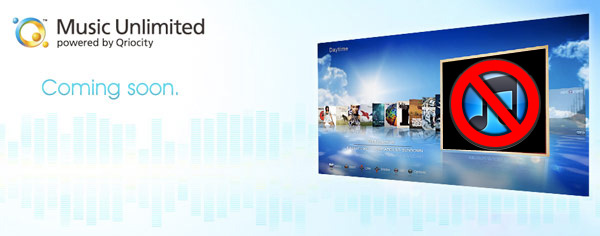
In December 2010, Sony began rolling out Qricoity Music Unlimited, a music streaming service that would enable Sony devices like the PlayStation 3, Bravia televisions, and Blu-ray players to have access to a library of over 6 million songs. The service first launched in the UK and Ireland and expanded quickly to France, Germany, Italy, and Spain in January with the US receiving it in February. The service comes at two price points, with $3.99 a month getting you the basic offerings and $9.99 a month landing you at the premium end of the service. What you think of the price point is an altogether different conversation, but the fact that Sony has been able to offer this service in so many different countries so quickly is something that should not be overlooked.
People often complain that they might not have Netflix in Europe or lack of Qriocity in Canada but the truth of the matter is, most of the time, the blame is placed on the wrong provider. Netflix would love to be in every country and Apple would love to give every iTunes user the same music/movie/TV show access, no matter your residence, but the fact of the matter is that they cannot. This is in part due to complicated copyright laws and country laws. While Universal Records might have have the rights to Lady Gaga in the US, the same might not be true in Europe and while Sony Pictures made Zombie Land, don’t be surprised if in the country you live, somebody else like Warner Brothers or Paramount actually distributed it. Add on top of that different legal requirements of the given country and you can quickly see why it’s not as simple as flipping a switch at Sony HQ and offering a service like Qriocity to other countries.
This brings us back to Qriocity and why it has 7 months to live. First, I have to say that I’m currently using Qriocity and although it’s not a service for me—and it’s not because I use other streaming services—I get it and like it. Many people don’t feel the need to own their music. Instead, they want a radio that is catered to them, and that’s what Qriocity basically is. It is a radio station that gives you access to millions of songs while allowing you to be the DJ. I realize that the future is in the cloud, so services like Qriocity and Pandora will eventually be the way, and Sony knows this too. But there is another slumbering giant that knows this as well. Apple singlehandedly changed the music industry with the iPod and iTunes, and while I won’t be getting into a history lesson about it, it’s an understatement to say that Apple has leverage and experience when it comes to negotiating deals and offering them in a consumer-friendly way.
In late 2009, Apple quietly purchased a small music streaming service called Lala and soon after began building the world’s largest data center. Apple not only knows that the future is in the cloud, but is also building a robust infrastructure to support their future plans. It’s no secret that when Apple releases a product, it’s a big deal, and it’s also no secret that every September, the iPod and iTunes family gets refreshed. With the data center now nearly complete and with two silent years come this September, you can bet that Apple will be announcing an iTunes music streaming service on top of their current standalone iTunes offering.
The minute this happens, Apple will have dwarfed any offerings from the likes of Sony because of sheer scale. Now every Mac, PC and iOS device like the iPod Touch, iPhone, iPad, and AppleTV will have access to their streaming service. Mix this with Apple’s relentless advertising campaign and you can see how a service like this will be if not an instant hit, far ahead of Sony’s Qriocity Music Unlimited. But despite these last two paragraphs, this is not a doom and gloom article for Qriocity. Instead, it’s recognizing what Sony is capable of doing if they use their might.
Sony might have been beaten in the last few years by companies like Apple, but the fact is that Sony is still a huge company that sells millions of devices. Offering Qriocity on the millions of Blu-ray players and Bravia TVs that Sony will sell is a good start. Also, Sony released Qriocity on the PlayStation 3 last week, instantly gaining a pool of 45 million devices, and the PSP will soon follow. This is a good first start but Sony needs to push for more. Sony Ericsson is planning on giving its soon-to-be-released Android Xperia lineup—the Xperia Play, Arc, Neo and Pro—Qriocity as well, but Sony can’t stop there. Apple has the added benefit of having their consumers’ lives revolve around iTunes which gives them access to books, apps, movies, TV shows, and more. With such a vast ecosystem set, picking up an Apple device is a safe bet and Apple can hedge your dependability on iTunes to sell more of their devices. Qriocity currently does not have the same track record, being the new offering that it is. So instead, Sony needs to expand this as fast as possible and consider that it doesn’t have to only offer Qriocity on its own devices, in order to have it as a check mark benefit of a Sony Ericsson vs. a Samsung phone. Qriocity needs to expand and a great hungry ecosystem out there is Android. Because there are millions of Android devices with no de-facto music service, Sony can give the Android market a a service similar to the iTunes Store and rally those users in its economic favor.
With millions of Sony products and Android-enabled phones having access to Qriocity, Sony now can fight off the Apple juggernaut. I say “can” because there is still one piece of the puzzle left, and that is marketing. As I mentioned before, one thing that Apple does well is marketing. Between the many different, simple and catchy TV, print, and online ads that Apple runs, there is nowhere you can turn without seeing Apple. Mix that with Apple’s ability to come up with catchy names, and you have yourself a hit. On the other hand, Sony has a poor track record of advertising, or lack thereof. Instead, Sony releases products in hopes that consumers will run into it or read a site likes ours and that unfortunately misses a large portion of potential buyers. And Qriocity Music Unlimited? Really? That’s like Apple calling iTunes Music Store. Sure Qricoty Music Unlimited gives you an idea as to what the service is for but it’s not catchy at all. Instead, they need to just hammer Qriocity into the consumer mind. Every exec and article needs to call the service Qriocity and with a proper advertisement campaign and education from Sony, everybody can learn that Qricoity is an unlimited music service. After all, prior to their release, who would have thought Hulu would be a movie streaming service? But it doesn’t matter now. The name is catchy and Hulu has educated the public as to what it is. Sony needs to, and can do the same with Qricoity.
In the end, Sony has the capability of releasing Qriocity on millions of self-made devices and millions more if they team up with Google and offer access to Android users. With a growing Sony Style retail presence and Sony’s many retail partners like Best Buy and Sears, Sony is a good advertisement campaign away, even if it’s kept to a tight but to the point message online (after all, Pandora does not have TV commercials), from having a successful stand against the inevitable music streaming service by Apple. All Sony needs to do is to keep a clear focus on the goal and put the entire weight of the company behind it and Sony can succeed where Microsoft with the Zune has failed.

You must be logged in to post a comment.